Longivarius W. Dong, H. Zhang & K.D. Hyde, gen. nov.
Index Fungorum number: IF557493; Facesoffungi number: FoF 09546
Etymology: – in reference to its long neck and various colour of ascospore cells
Saprobic on submerged wood.
Sexual morph: Ascomata solitary, semi-immersed or superficial, globose, brown to dark brown, ostiolate, periphysate, with a prominent neck. Neck relatively long, cylindrical, curving or becoming erect. Peridium thick-walled, brown, comprising pseudoparenchymatous cells. Paraphyses filiform, septate, hyaline, simple to rarely branched. Asci 8-spored, unitunicate, cylindrical, short pedicellate, with a distinct, wedge-shaped, J-, apical ring. Ascospores uniseriate to overlapping biseriate in the ascus, fusoid to lunate, straight to slightly curved, 3-septate, central cells brown, end cells subhyaline, smooth-walled, without appendages or sheath.
Asexual morph: Undetermined.
Type species: – Longivarius aquatorbae (Boonyuen & Sri-indr.) W. Dong, H. Zhang & K.D.Hyde
Notes: – Annulatascus aquatorbae was collected from submerged wood test block of
Erythrophleum teysmannii in Thailand (Boonyuen et al. 2012). It was placed in Annulatascus based on its cylindrical asci with a relatively large, refractive apical ring and 3-septate ascospores (Boonyuen et al. 2012). However, A. aquatorbae is distinctive by unevenly colored ascospores with brown central cells and subhyaline end cells, contrasting with the hyaline ascospores of other Annulatascus species, including our three new species. In addition, A. aquatorbae forms a separated clade from Annulatascus species in our updated phylogenetic tree (Fig. 1), which corroborates other studies (Luo et al. 2015, 2019, Hyde et al. 2018, 2020). Annulatascus aquatorbae has been missing for almost 20 years since it was first collected in Thailand in 2003 (Boonyuen et al. 2012). In order to widen the taxonomic study of Annulatascaceae, we establish a new genus Longivarius to accommodate A. aquatorbae based on distinct morphology and phylogenetic analyses.
The unevenly colored ascospores are key generic features of several genera, such as Ascitendus (Annulatascaceae) (Campbell & Shearer 2004), Byssothecium (Massarinaceae) (Pem et al. 2019, Dong et al. 2020b) and Savoryella (Savoryellaceae) (Dayarathne et al. 2019). Longivarius is related to Ascitendus in Annulatascaceae, but they are in two distinct clades (Fig. 1). Longivarius is similar to Ascitendus in having dark ascomata with a prominent neck, cylindrical asci with a distinct apical ring, and 3-septate, fusiform ascospores. However, the asci of Longivarius have a wedge-shaped apical ring, while they are cylindrical to flaring in Ascitendus. In addition, the ascospores of Longivarius have darker central cells and paler end cells. This character is also described in Ascitendus, but not as obviously as in Longivarius. Phylogenetic analysis supports them to be different genera (Fig. 1). Although Longivarius has a weak relationship with Annulatascaceae members (Fig. 1), it is temporarily placed in Annulatascaceae based on current phylogenetic analysis.
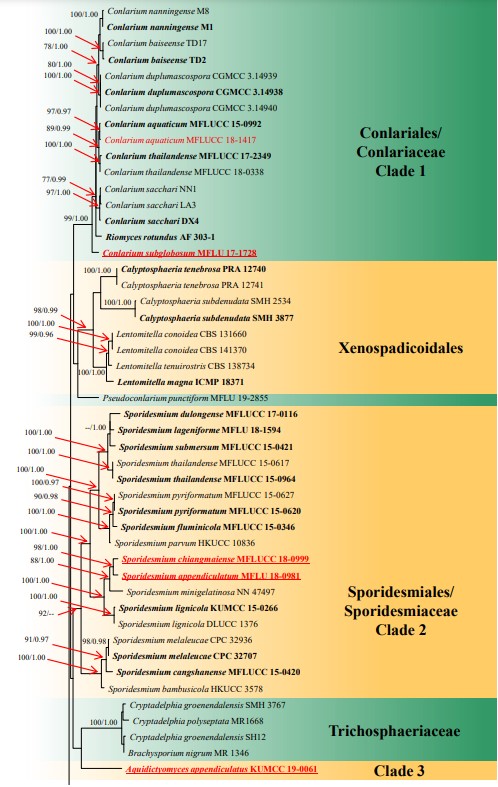
Figure 1 – RAxML tree generated from combined LSU, ITS, TEF and RPB2 sequence data. Bootstrap support values for maximum likelihood (the first value) equal to or greater than 75% and Bayesian posterior probabilities (the second value) equal to or greater than 0.95 are placed near the branches as ML/BYPP. The tree is rooted to Aureobasidium pullulans CBS 584.75 and Dothidea insculpta CBS 189.58. The ex-type strains are indicated in bold and newly generated sequences are indicated in red. The new species introduced in this study are underlined.
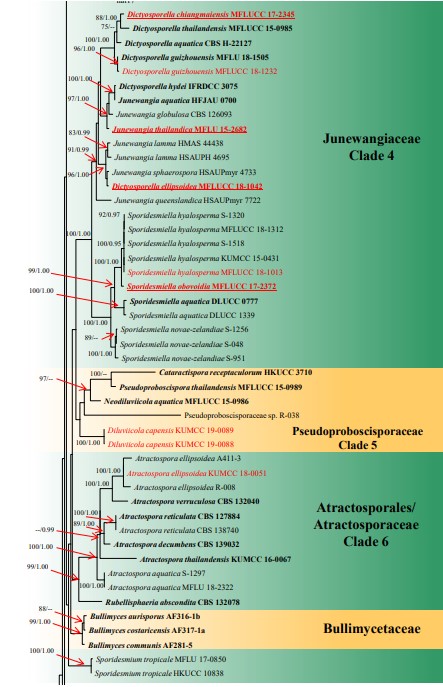
Figure 1 – Continued.
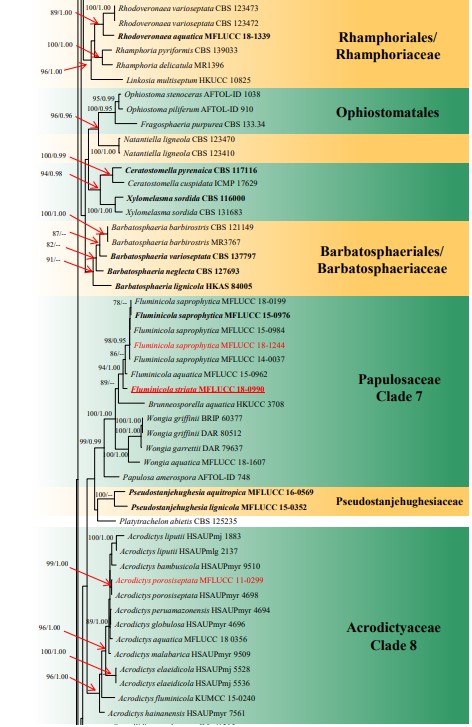
Figure 1 – Continued.
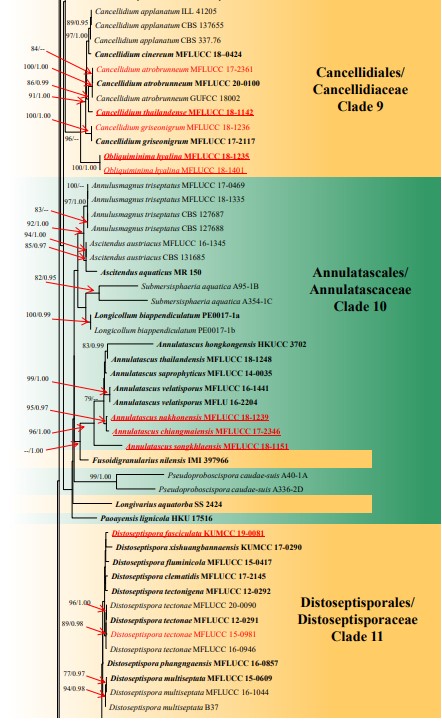
Figure 1 – Continued.
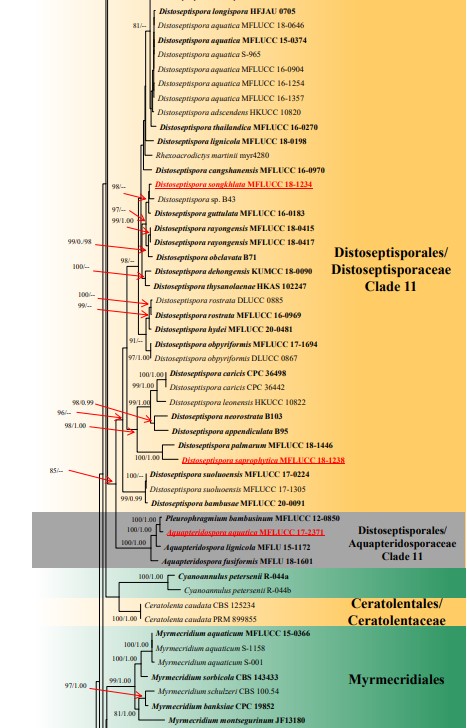
Figure 1 – Continued.
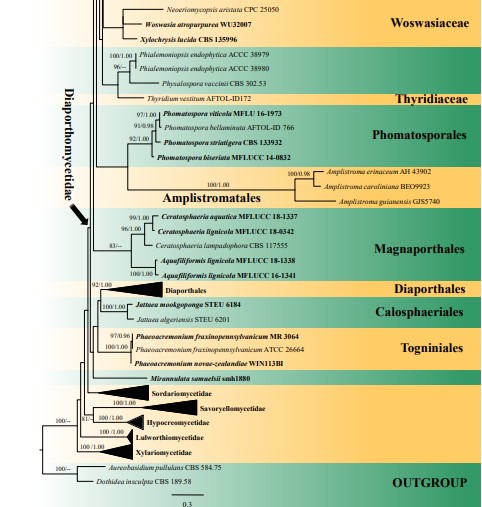
Figure 1 – Continued.
Species
